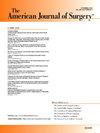Risk factors and outcomes of cardiac arrest in pediatric traumatic brain injury patients
IF 2.7
3区 医学
Q1 SURGERY
引用次数: 0
Abstract
Background
Cardiac arrest (CA) in pediatric traumatic brain injury (pTBI) is associated with morbidity. Our objective is to investigate the incidence, risk factors, and outcomes for CA following pTBI.
Methods
The Kid Inpatient Database (KID) was queried for patients with pTBI. Patients who experienced CA were identified. Demographics, comorbidities, hospital course, and complications were compared between patients who developed CA and who did not. Risk factors for CA were explored using multivariate analysis.
Results
CA patients were more likely to have hypertension, hypertrophic cardiomyopathy, and heart defects (p < 0.01). CA was more likely in patients with subdural bleeding, cerebral edema, herniation, coma, or mechanical ventilation (p < 0.001). CA patients had higher odds of vasopressor and transfusions, tracheostomy, percutaneous endoscopic gastrotomy (p < 0.001), and mortality (p < 0.01). Mechanical ventilation, cerebral edema, heart, vasopressor use, and transfusions were associated with CA on multivariate analysis.
Conclusion
Risk factors for CA in pTBI patients include severity of injury and underlying cardiovascular abnormalities. CA was associated with morbidity and resource utilization in pTBI patients.
小儿脑外伤患者心脏骤停的风险因素和结果。
背景:小儿创伤性脑损伤(pTBI)中的心脏骤停(CA)与发病率有关。我们的目的是调查 pTBI 后心脏骤停的发生率、风险因素和结果:方法:对儿童住院患者数据库(KID)中的 pTBI 患者进行查询。方法:对儿童住院患者数据库(KID)中的 pTBI 患者进行查询,确定了发生 CA 的患者。比较了发生CA和未发生CA的患者的人口统计学特征、合并症、住院过程和并发症。通过多变量分析探讨了CA的风险因素:结果:CA 患者更有可能患有高血压、肥厚型心肌病和心脏缺陷(p 结论:CA 患者更有可能患有高血压、肥厚型心肌病和心脏缺陷:创伤后应激障碍患者发生 CA 的风险因素包括损伤的严重程度和潜在的心血管异常。CA与创伤性脑损伤患者的发病率和资源利用率有关。
本文章由计算机程序翻译,如有差异,请以英文原文为准。
求助全文
约1分钟内获得全文
求助全文
来源期刊
CiteScore
5.00
自引率
6.70%
发文量
570
审稿时长
56 days
期刊介绍:
The American Journal of Surgery® is a peer-reviewed journal designed for the general surgeon who performs abdominal, cancer, vascular, head and neck, breast, colorectal, and other forms of surgery. AJS is the official journal of 7 major surgical societies* and publishes their official papers as well as independently submitted clinical studies, editorials, reviews, brief reports, correspondence and book reviews.

 求助内容:
求助内容: 应助结果提醒方式:
应助结果提醒方式:


